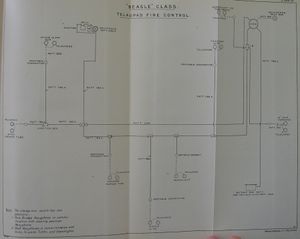Beagle Class Destroyer (1909)
Sixteen destroyers of the Beagle Class were ordered as part of the 1908-1909 Naval Programme.
They inaugurated the use of 21-in torpedoes on Royal Navy destroyers.
Between April and October, 1910, they comprised the First Destroyer Flotilla. In 1911, they were sent to the Mediterranean to become the Fifth Destroyer Flotilla during the Dardanelles operation. They were re-designated the "G" class in October 1913.[1]
They burned coal and were, at 27 knots, about 6 knots slower than the "Tribals".[2]
Performance
Beagle steamed at over 27 knots for 4 hours burning over 11.5 tons of coal per hour, making 2.32 miles per ton — a little below the average for the class. Rattlesnake had the best tactical diameters of 382 yards to starboard and 457 yards to port, while Harpy was worst with 802 and 887 yards. The rudders were 55 square feet, but hull lengths ranged from 266 to 275 feet.[3]
On a patrol exercise with "Tribals", the Tribals returned early as they were short of fuel, whereas the Beagles had 30-40 tons of coal remaining. Similar comparison tests seem to confirm a greater endurance for the Beagles. The ships lacked any heating arrangements and men were unable to sleep in the extreme cold.[4]
In the Dardanelles during February, 1915, Beagle had her boilers lit for 26 consecutive days.
Armament
Guns
Their gun armament was to persist through the Acheron class with variation in mountings and arrangement in Acheron:
- One 4-in Q.F. Mark VIII (or low velocity BL) gun on P III mounting forward[5] with 120 rounds per gun
- Three 12-pdr 12 cwt Q.F. guns on P V mountings[6] with 100 rounds per gun,[7] two in echelon on the beam and one aft
Torpedoes
Two single 21-in tubes on the centre line, one right aft, firing the short 18.5-foot Mark I.[8]
Some of the ships were equipped with Fore Bridge Firing Gear, either upon completion or prior to 1911.[9]
Other Weapons
In mid-March 1916, Type D depth charges were fitted on either side of Scorpion's stern. In June 1918, Harpy had two Thornycroft depth charge throwers, 16 carriers, 2 runners and 50 depth charges, adding to 18 tons additional weight.[10]
Control
The ships were probably completed with the Navyphone and Telaupad circuitry outlined in the Handbook of Fire Control Instruments, 1909[11] for control of gunnery, searchlights and torpedoes. It was powered by six Pattern 1453 cells.
Each gun, torpedo tube and searchlight had a set of telaupads, and there were navyphones on fore bridge (a Pattern 863) and in the aft steering position (a Pattern 2140A). The commander of Bulldog had many complaints about the ship, including that "navy-phones no good."[12]
The C.O.S. on the fore bridge had two positions:
- Fore bridge Navyphone tied to after steering position Navyphone
- both Navyphones in communication with all Telaupads
By 1915, at least, these ships also had fixed voice pipes installed between decks with the last lengths being flexible (one voice pipe for gunnery, one for torpedoes) fitted between bridge and guns, torpedo tubes, and searchlights. A third voicepipe, entirely flexible, ran from bridge to the forward gun.[13]
Fire Control Instruments
Torpedo Control Instruments
There was torpedo fore bridge firing gear.[14]
See Also
Footnotes
- ↑ Conway's All the World's Fighting Ships, 1906-1921, p. 73.
- ↑ Technical History and Index Vol. 4, Part 34, p. 11.
- ↑ March, p. 106.
- ↑ March, p. 106.
- ↑ BL per Technical History and Index Vol. 4, Part 34, p. 11, QF per Conway's All the World's Fighting Ships, 1906-1921, p. 73.
- ↑ The Sight Manual, 1916, p. 112.
- ↑ March, p. 101.
- ↑ Annual Report of the Torpedo School, 1909, p. 32.
- ↑ Annual Report of the Torpedo School, 1916, p. 31.
- ↑ March, p. 108.
- ↑ Handbook of Fire Control Instruments, 1909, p. 52, Plate 55.
- ↑ March, p. 107.
- ↑ Manual of Gunnery, Vol. III., 1915., p. 150.
- ↑ March, p. 104.
Bibliography
